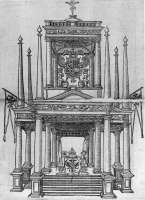This is a story of art, architecture, media, and politics in the middle of the sixteenth century.
From the fall of 1558 to the fall of 1559, towering black monuments were built throughout the Mediterratlantic world. They honored Charles V, former king of Spain and Holy Roman Emperor. Retired from public life since 1556, Charles had died at a monastery in southwest Iberia on September 21, 1558.
Official word of his passing was sent out in a royal decree twelve days later, on October 3. In the weeks and months that followed, copies of this document slowly traveled across Charles V’s former empire. When the news arrived, local govern- ments began to plan memorial rites. In at least twenty cities spanning Europe and the Americas, massive funerary monuments were constructed. These ephemeral túmulos served as centerpieces for two days of processions, masses, and mourning.
Although none of the memorials built for Charles V survives today, many were richly documented in alphabetic and visual accounts. This article centers on one such publication: Francisco Cervantes de Salazar’s Tvmvlo Imperial, an illustrated book recording the commemorations held in Mexico City on November 30 and December 1, 1559. The book is one of several sources about Mexico City’s monument, a monument itself generated from the words and images of printed books, and this movement (from textual inscriptions to three-dimensional installation to textual inscriptions again) will be tracked across the pages to come.
TO ACCESS THE FULL TEXT, PLEASE CLICK THE “DOWNLOAD PDF” LINK


